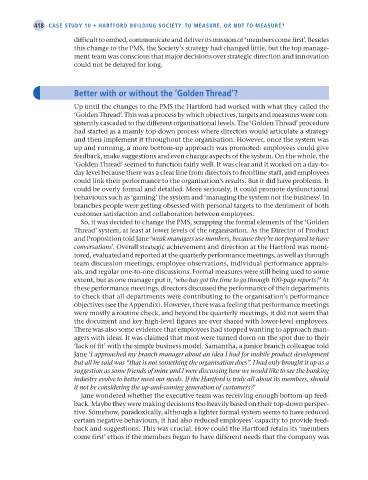Page 443 - Operations Strategy
P. 443
418 case study 10 • Hartford Building society: to measure, or not to measure?
difficult to embed, communicate and deliver its mission of ‘members come first’. Besides
this change to the PMS, the Society’s strategy had changed little, but the top manage-
ment team was conscious that major decisions over strategic direction and innovation
could not be delayed for long.
Better with or without the ‘golden thread’?
Up until the changes to the PMS the Hartford had worked with what they called the
‘Golden Thread’. This was a process by which objectives, targets and measures were con-
sistently cascaded to the different organisational levels. The ‘Golden Thread’ procedure
had started as a mainly top-down process where directors would articulate a strategy
and then implement it throughout the organisation. However, once the system was
up and running, a more bottom-up approach was promoted: employees could give
feedback, make suggestions and even change aspects of the system. On the whole, the
‘Golden Thread’ seemed to function fairly well. It was clear and it worked on a day-to-
day level because there was a clear line from directors to frontline staff, and employees
could link their performance to the organisation’s results. But it did have problems. It
could be overly formal and detailed. More seriously, it could promote dysfunctional
behaviours such as ‘gaming’ the system and ‘managing the system not the business’. In
branches people were getting obsessed with personal targets to the detriment of both
customer satisfaction and collaboration between employees.
So, it was decided to change the PMS, scrapping the formal elements of the ‘Golden
Thread’ system, at least at lower levels of the organisation. As the Director of Product
and Proposition told Jane ‘weak managers use numbers, because they’re not prepared to have
conversations’. Overall strategic achievement and direction at the Hartford was moni-
tored, evaluated and reported at the quarterly performance meetings, as well as through
team discussion meetings, employee observations, individual performance apprais-
als, and regular one-to-one discussions. Formal measures were still being used to some
extent, but as one manager put it, ‘who has got the time to go through 100-page reports?’ At
these performance meetings, directors discussed the performance of their departments
to check that all departments were contributing to the organisation’s performance
objectives (see the Appendix). However, there was a feeling that performance meetings
were mostly a routine check, and beyond the quarterly meetings, it did not seem that
the document and key high-level figures are ever shared with lower-level employees.
There was also some evidence that employees had stopped wanting to approach man-
agers with ideas. It was claimed that most were turned down on the spot due to their
‘lack of fit’ with the simple business model. Samantha, a junior branch colleague told
Jane ‘I approached my branch manager about an idea I had for mobile product development
but all he said was “that is not something the organisation does”. I had only brought it up as a
suggestion as some friends of mine and I were discussing how we would like to see the banking
industry evolve to better meet our needs. If the Hartford is truly all about its members, should
it not be considering the up-and-coming generation of customers?’
Jane wondered whether the executive team was receiving enough bottom-up feed-
back. Maybe they were making decisions too heavily based on their top-down perspec-
tive. Somehow, paradoxically, although a lighter formal system seems to have reduced
certain negative behaviours, it had also reduced employees’ capacity to provide feed-
back and suggestions. This was crucial. How could the Hartford retain its ‘members
come first’ ethos if the members began to have different needs that the company was
Z10 Operations Strategy 62492.indd 418 02/03/2017 13:54

